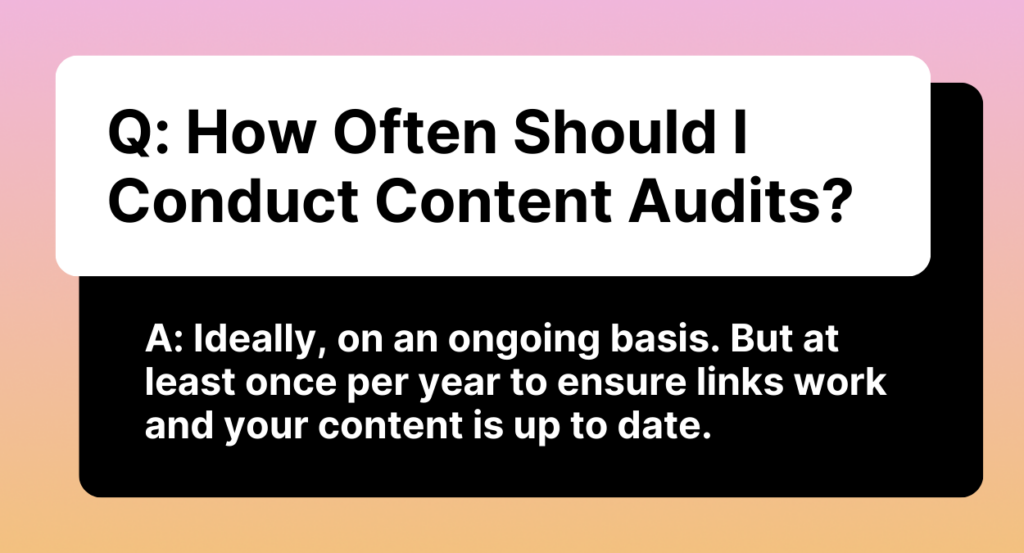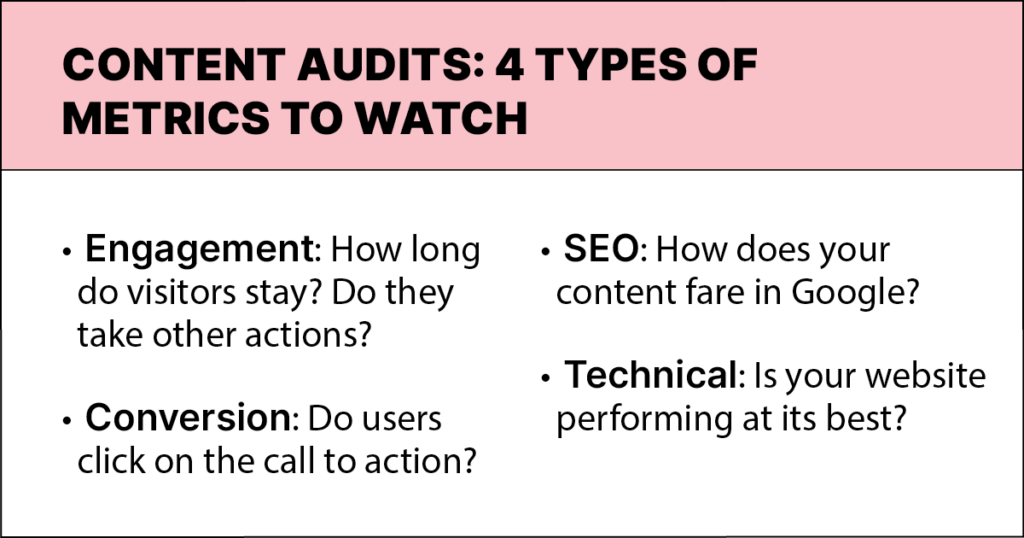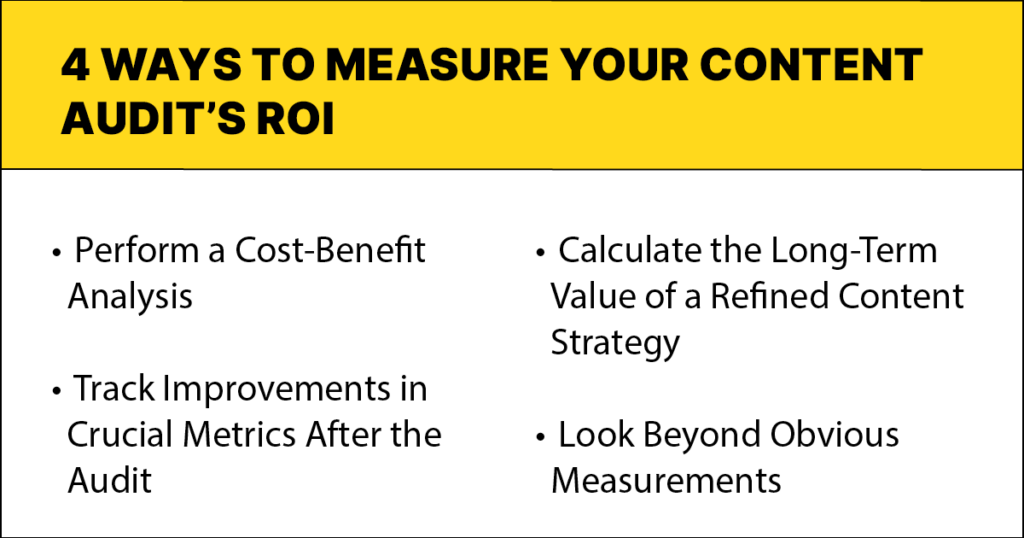Creating outstanding content is only one part of an effective content marketing strategy. To be successful, you must ensure the content reaches its intended audience and fulfills specific business objectives over time. That’s where content audits play a critical role.
What Is a Content Audit?
Imagine a health checkup, but for your content. That’s essentially what a content audit is. It offers a thorough, systematic evaluation of all content, usually within a website or blog. Content audits can also apply to social media channels, such as YouTube, and other digital properties.
The goal of a content audit is to assess quality, relevance to your target audience, performance and alignment with search engine optimization (SEO) requirements. Performing a content audit involves cataloging your content library, analyzing performance metrics and making recommendations for improvement.
Why are content audits so pivotal? For starters, they help businesses identify high-performing content and areas that need a boost. They can spotlight “low-hanging fruit” that can achieve quick SEO wins with relatively minor optimization.
Moreover, audits work best when they are recurring. Regular audits can pinpoint outdated or irrelevant content that might hamper a site’s credibility. They also reveal content gaps, offering opportunities to create new, authentic content that can drive organic traffic and build thought leadership.
Content audits also play a crucial role in enhancing user experience. When content is relevant and easily accessible, companies can increase user satisfaction, reduce bounce rates and boost the time spent on the site. Additionally, a well-structured website is easier for search engines to crawl, enhancing overall SEO.
How Often Should You Conduct a Content Audit?
Content audits should be part of a regular checkup for your website and other digital properties. Ideally, you’d conduct audits continuously. However, if that’s not feasible, content audit best practices mandate a full or partial audit at least once per year to ensure links work and your key data points and assertions still apply.
Frequent content audits help you track how content performs over time, offering insights into what’s not working and what you need to change. Audits will also give you up-to-date data that informs your content strategy and reveals insights about the business. With business and society in constant flux, your content must be as fresh, high quality and distinct as possible.

Content Audits for B2B Enterprises
Content audits take on added significance for business-to-business (B2B) enterprises. B2B buying processes can be lengthy and involve multiple stakeholders, each with unique needs. A B2B content audit ensures that content caters to all these personas. With complex and extended B2B sales cycles, content audits make sure businesses have content for every stage of the buyer’s journey.
Regular content audits also help B2B businesses maintain their position as thought leaders — that their content not only reflects the latest industry trends but also advances key conversations. Audits factor into B2B SEO, too, helping companies improve audience targeting to increase visibility and key touch points.
Auditing Past Blog Content: An Untapped Opportunity
While fresh content is vital, there’s immense value in auditing past blog content. Older blog posts might still be relevant and attract a steady stream of traffic. They often have high authority in Google and other search engines. This existing clout makes them prime candidates for updates that retains this clout and optimizes for any industry changes.
Updating old content can improve rankings and user experience while capturing new keywords. A case in point is Backlinko’s content audit guide. (Backlinko is an SEO training and link-building strategy company.) The audit enabled the company to rejuvenate fading content, resulting in a 33.88% surge in search engine traffic.
Benefits of Regular Content Audits
Regular content audits offer wide-ranging benefits. Here are some of them:
- Building trust and authority: Audits keep your content current and reflective of industry trends. Readers find your content valuable and recognize your brand as a trustworthy source.
- Better search rankings: Optimizing old content with high-performing keywords can significantly boost organic traffic and ensure you stay competitive in search rankings. You can also improve your site’s SEO prospects by removing content that’s outdated or competes with better content you’ve also published.
- Enhanced user experience: Eliminating redundant content improves the user experience and contributes to a streamlined user journey for interested buyers. You can also use content audits to update and improve calls to action, driving interested readers to the next stage.
- Improved website maintenance and management: Content audits can be powerful for identifying broken links, creating redirects for posts you shelve, and diagnosing other technical issues, such as page-loading times.
- Competitive advantage: Conducting a gap analysis can help you stay ahead of competitors and align your content more closely with audience needs.
Challenges in Conducting Content Audits
While content audits offer numerous benefits, they can come with far-reaching challenges:
- Too much content: The sheer volume of content, especially for older websites with large content libraries, can be intimidating. Cataloging and assessing hundreds or thousands of pieces of content can be daunting.
- Hidden or forgotten content: Not all content is easily accessible or remembered. Older articles that aren’t prominently linked or are misclassified can be easily missed during an audit, leading to incomplete evaluations.
- Subjectivity: Different auditors might have contrasting views on what constitutes “quality” content, leading to inconsistent audit results. Without a well-defined set of criteria for evaluating content quality, the audit process can become arbitrary. This can reduce the audit’s effectiveness and your content marketing team’s trust in the process.
- Not enough time or money: A thorough content audit can be lengthy, especially for larger websites. For example, fixing broken links or incorrect redirects can be tedious and time-consuming — and you might not have the staff to spare or the money to spend on labor or audit tools.
- Stakeholder resistance: Stakeholders might have strong ties to specific content pieces, making it challenging to propose alterations or removal.
- Technical challenges: Some content management systems may not offer easy access to all content pieces or the necessary analytics, complicating the audit process.
Key Content Audit Metrics
Metrics play a pivotal role in content audits. Some of the essentials include:
- Engagement metrics like time on page, bounce rate, click-throughs on links and social shares provide insights into user satisfaction.
- Conversion metrics measure the ROI of content, indicating how effectively it drives users toward desired actions.
- SEO metrics gauge content authority, freshness and visibility for Google and other search engines. Within blog posts, you can look at keyword rankings, internal links, backlinks and more.
- Technical metrics highlight whether your website is supporting your content. Look at page load time, pages indexed and mobile responsiveness.

Content Audit Case Studies
Looking at what other brands have done can inspire your content audit efforts. Let’s examine how a content marketing agency (via Semrush) and digital marketing blog (via Smash Digital) use content audits to drive growth.
Uplift Content
Background
Uplift Content is a content marketing agency specializing in case studies, e-books and blog posts for high-growth B2B software-as-a-service companies. In the competitive B2B SaaS industry, establishing a solid brand presence and gaining traction is challenging.
Problem
Despite possessing the expertise to craft compelling marketing content, Uplift Content grappled with a significant challenge: the absence of a robust SEO strategy. This oversight meant that their high-quality content wasn’t getting the visibility it deserved — and the brand and business suffered as a result.
Solution
The company recognized the need for change and embarked on an SEO overhaul. Uplift Content brought in a third party to conduct keyword research, manage content inventory, track goals, use better tools and much more. A significant part of the strategy shift was using keyword research insights to create new content and optimize existing content.
Results
While only spending two hours a week for a year on SEO efforts, Uplift Content witnessed many benefits in terms of traffic, conversions and keyword capture. Most notably, the company saw 50% year-over-year revenue growth.
Well-Known Digital Marketing Blog
Background
A renowned digital marketing blog changed ownership, and traffic fell quickly — from 155,000 visitors in January to 47,000 by June.
Problem
The new owners tried to improve content quality and address on-page SEO issues, but traffic plummeted, which hurt revenue and the value of the acquisition. A deeper dive revealed the magnitude of the problem: The site boasted over 1,000 blog posts, but many were outdated or riddled with questionable outbound links.
Solution
Smash Digital recognized the gravity of the situation and conducted a comprehensive content audit. Their strategy was multi-pronged:
- Purge pages that attracted little or no traffic, backlinks or leads.
- Modify or remove pages with dubious outbound links.
- Delete or update content that lost relevance.
- Revitalize top-performing pages to ensure they remained current and valuable to readers.
Results
The turnaround was swift and impressive. The recommended changes created a 76.54% uptick in organic traffic within weeks, creating momentum to continue the gains while revamping the overall content strategy.
How to Conduct a Content Audit
A content audit isn’t just about reading blog posts. It also requires examining internal links, backlinks and landing pages. Be prepared to spend a lot of time staring at spreadsheets.
You’ll also want to be clear about the audit’s goals — how will this audit help the business? An audit designed primarily to improve SEO will likely follow a different path than an audit focused on improving conversion rates.
To get started with a content audit, follow these three steps.
1. Create a Content Inventory
This step is where you track down and document all content on your website or other applicable digital property, including archived content. Most people gather this information in a content audit spreadsheet with such details as:
- Publication date
- Category
- Content title
- Content ownership
- Keyword
- Description
- Meta description
- Author/writer
- Format
- Length of the post (optional)
- Relevant performance metrics (cost per click, bounce rate, views, etc.)
You can create a spreadsheet and enter the information manually or use an auditing tool for a faster process. A content audit tool will crawl your website and collect the necessary data. Depending on your chosen tool, you can access or download detailed reports that give you an overview of your website’s current state.
2. Assess Your Content Performance Data
You’ve got all your content and its information listed in one place. Now, it’s time to look at those performance indicators mentioned in the first step. By understanding the data you have, you can make educated decisions that further your content audit goals.
Take note of bounce rates, which posts have the most views, the topics people appear to gravitate toward and which posts are underperforming. You should also look for signs that pieces of content might be stale, outdated or inaccurate, especially for topical content, such as events coverage or reactions to news.
For SEO content, especially, look at what’s attracting traffic and ranking highly — and whether once-powerful posts have slipped. To fix the laggards, you might only need slight adjustments, or you might need a complete rewrite. If you’ve written many posts on the same topic and keywords, consider consolidating them into one stronger piece of content. These are often called pillar pages or topic clusters.
Other aspects that can signal whether your content needs a refresh include:
- Performance: Low-performing content can have an outstanding thesis or powerful ideas but be executed incorrectly. Don’t discard those nuggets of wisdom; improve them!
- Product launches: If you launch or revise a product, revamp or sunset old product content to avoid any discrepancies or confusion.
- “Staff” bylines: Connect existing content with a face and voice within your company — usually an executive or a subject matter expert. This isn’t just for thought leadership; Google increasingly considers authority and expertise in its rankings. But make sure to redirect or delete links that no longer have voice or business relevance.
- Generic content: Instead of overproducing generic content around your topic, revamp it to focus on your unique value proposition. Most brands will struggle to compete on the most broad, highest difficulty keywords, anyways.
- Gated content: If you’ve gated content such as guides or e-books, the number of downloads can help you determine what your audience wants to read, watch or listen to. The download data might also give you ideas for content you currently lack. Or you might decide that the SEO value of this content is more valuable, and you can un-gate the piece.
As you go through and identify content that needs updating, account for SEO elements. Ensure that any content refresh or consolidation includes reassessing your keywords, SEO titles and meta descriptions.
3. Create and Implement a Content Update Plan
After you’ve gathered your content and analyzed the data, it’s time to create a plan for implementing the strategic changes. The goals and vision for your website will help you decide which content should be updated and released first.
For example, an entrepreneur runs a beauty line but wants to rebrand it as a lifestyle brand. The content audit could focus on updating or creating content for the new products and themes the company now wants to associate with. This content strategy could combine SEO and thought leadership content on topics that highlight the brand’s new direction.
Essential Content Audit Resources
Tools like Google Analytics, Screaming Frog, Semrush, Ahrefs and Google Search Console are invaluable for conducting content audits. Consider content marketing audit templates to make the process easier and ensure that each audit is conducted the same way. Here are some of the leading tools, although far from the only options.
Traffic and User Engagement Metrics: Google Analytics
Google Analytics is a comprehensive platform that provides insights into how users interact with your content. It offers data on page views, session durations, bounce rates and more.
Website Crawling Tool: Screaming Frog
Screaming Frog is a powerful tool that crawls your website to provide a snapshot of its current state. It can identify broken links, duplicate content and other technical issues.
Keyword Research and Online Ranking Data Tool: Semrush
Semrush is a multifaceted tool offering deep research capabilities that help you understand the terms your content ranks for, diagnose keyword gaps and identify potential keyword opportunities.
SEO Tool for Link Profiles, Keyword Rankings and SEO Health Analysis: Ahrefs
Ahrefs provides a comprehensive overview of your website’s SEO health, backlink profile and keyword rankings.
How Google Views and Indexes Your Content: Google Search Console
Google Search Console offers insights into how Google’s search algorithm views your content — providing data on crawl errors, indexing status and more.
Content Marketing Audit Templates
Content audit templates offer a structured approach to content auditing. They often come with predefined fields and categories, making the auditing process more organized and efficient.
Many brands offer free, sample content audit templates, including WordStream, GatherContent and Web Ascender.

Measuring the ROI of Content Audit Investment
Understanding the return on investment (ROI) of a content audit is crucial for businesses so they can make informed decisions about what to keep doing and where to adjust their strategy. Here are four areas of ROI to look for when measuring your content audit investment:
Perform a Cost-Benefit Analysis
It’s essential to weigh the costs associated with the content audit, including expenses for tools, staffing and time. By comparing these costs with tangible benefits, such as increased traffic and conversions, businesses can determine the audit’s financial viability and effectiveness.
Track Improvements in Crucial Metrics After the Audit
Post-audit, can you track and report on critical metrics like organic traffic, bounce rate and conversion rate? These metrics provide a clear picture of how the audit-influenced changes affected website and SEO performance.
Calculate the Long-Term Value of a Refined Content Strategy
A well-executed content audit can lead to long-term benefits. By regularly refining the content strategy based on audit insights, businesses can achieve sustained growth in traffic, engagement and conversions. By making this process a habit, your brand can also quickly pivot if an aspect of the strategy stops working.
Look Beyond Obvious Measurements
While content audits are measurable, you can also realize powerful business benefits that are less tangible. These benefits include:
- Informed decision-making. Audits reveal the truth of your content, helping businesses make data-driven decisions about content creation, optimization and promotion.
- Better budget allocation. A clear understanding of ROI helps businesses allocate budgets more judiciously, directing resources towards high-impact content initiatives that promise better returns.
- Stakeholder buy-in. Demonstrating a positive ROI can garner support from stakeholders, ensuring continued backing for content-related endeavors.
- Competitive advantage. Businesses that diligently measure and act on their content audit ROI are better poised to outpace competitors in terms of content quality, relevance and online presence.
Make Content Audits a Habit at Your Company
Regular content audits are essential for content marketing success, especially for B2B companies. Collect the people, tools and resources you need to conduct content audits effectively, then build the process into your content strategy. The lessons from content audits will ensure that your content stays up to date, increases organic traffic, improves user experience and audience relevance, and generates more business.
To get more expert insights and helpful tips like these, subscribe to Managing Editor’s weekly newsletter.






